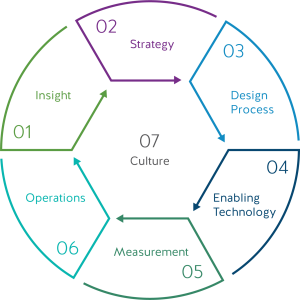Delivering seamless, consistent, and engaging experiences starts with a customer-centered digital strategy. This ongoing series explores the characteristics that make up a great digital strategy and how to deliver powerful brand moments that solidify customer loyalty and drive differentiation for your organization.
Frictionless service means never getting in the way of the moments that serve your customers. And, delivering a frictionless experience is no small feat. You have to raise the bar and provide consistency across all possible touchpoints for customers interacting with your brand.

Convenience and immediacy. This is the experience customers want, and what they’ve come to expect. While frictionless service is fully expected in retail, it has also shaped consumers’ expectations to the point that they demand this level of service with every brand in every category.
We sat down with David Stallsmith, a Director of Strategy and Innovation in Perficient Digital, and Jim Hertzfeld, Perficient Digital’s Chief Strategist, to understand the importance of frictionless service moments for transforming your digital experience.
Why are frictionless service moments important to a brand?

Perficient Digital’s CXIQ Maturity Assessment measure the seven dimensions of CX capabilities
David Stallsmith: They’re important because most brands have some element of “simple and easy” contained in their brand promise. But you can’t paper over a bad experience. You can’t shine it up, add bells and whistles, call it “frictionless,” and be done. If you’re not addressing systemic issues deep within your organization to remove users’ pain points, then the facade will crumble quickly.
One challenge CMOs and other leaders face is identifying the barriers that cause friction. What are the friction points, how do you make them disappear, and how should you prioritize those solutions?
Start by empathizing with your customers’ needs, and then, examine your business to gauge maturity of your CX capabilities. Then, you have the understanding on how your organization is poised to deliver on the promise of frictionless service. We often recommend an organizational diagnostic called CXIQ, which helps clients quickly understand their strengths and gaps relative to CX maturity.
What risks do organizations face by not providing frictionless service moments?
Jim Hertzfeld: Customer expectations are always evolving, and they don’t necessarily relate to direct competitors. These expectations are shaped by digital experiences from any industry category.
For example, let’s say you’re shopping on Amazon, and then minutes later you stop because you get a call from school that your child is sick. Maybe you go to your health insurance site to find a doctor that’s in-network. Or, you go to your pediatrician’s website to schedule an appointment.
That experience you just had with one brand shapes your expectations for experiences you will have with others. You expect the experience to be just as easy, satisfying, and informative. And when your business or organization doesn’t meet those expectations, your customers are disappointed.
All things being equal – price, quality, and service – service is always going to win. It’s even more important now because it’s possible to provide service at any point of the journey.
The inherent risk for organizations today is not meeting increasing customer expectations when service and experience are what defines the brand.
How do CMOs plan for, or address, factors beyond their control?
JH: If your brand wants to create a frictionless experience that spans the entire journey, the tricky part is that the CMO doesn’t own the journey. S/he has to partner with the entire organization, and every business is different. In some cases, the CMO may be the voice or biggest advocate for the customer, but they may also be the only voice.
DS: This is why creating a digital strategy is so important. It provides direction and serves as the guide your organization can rally around. Having a vision and being able to state your value proposition in the customers’ terms helps you convince your executive team and leadership that your cause is just. You’re enlisting their help in breaking down barriers and investing in the kind of change that’s required to have meaningful impact.
Which tools are essential for CMOs to create frictionless service moments?
DS: Creating and sharing personas and customer journeys are critical. Personas aren’t some magical thing. They’re simply a tool for collaborating to understand users’ unmet needs. They help teams keep the end user in mind when designing experiences.
When your team has a brainstorm or critiques design work, having a customer-centric mindset is invaluable. It allows you to reference types of customers and their needs. This mindset also assumes that customers have different needs, and it allows your company to serve a variety of customer types.
Usability testing is another excellent tool to use throughout the design process. It helps expose any remaining issues that could cause friction prior to development and launch.
Additionally, there are different kinds of pre- and post-launch testing methods that a CMO should have in his/her arsenal. Understanding customers’ perception and attitude of a product or a brand is important. Many companies use a tool like Net Promoter Score to measure brand health.
Then, sharing design feedback across teams is key for collaboration. Feedback on customer satisfaction and brand perception should be shared with the entire company. However, the environment for sharing this information requires trust so that the feedback can be integrated for improving products and services.
Which technologies rise to the top in terms of creating frictionless CX?
 JH: In the last six or seven years, we’ve seen omnichannel as a major focus area for a lot of our clients. Creating an omnichannel experience boils down to one thing – data and content integration. It’s the one common enabling technology.
JH: In the last six or seven years, we’ve seen omnichannel as a major focus area for a lot of our clients. Creating an omnichannel experience boils down to one thing – data and content integration. It’s the one common enabling technology.
Let’s think about systems in a couple of ways. When you make an online purchase, there are all these things we don’t think about that are in the background and make the transaction possible: CRM, payment processing, linking payments to an order, relaying the order for fulfillment and shipping, and then notifying the call center when an online order is placed.
All of this is just plumbing. What’s challenging about these great front-end technologies is that it’s really hard to orchestrate the data and content on the back-end.
You can have all the ideation, strategy, and executive buy-in [to build this experience]. But if your company doesn’t have the technologies to find data and content, and then extract, mediate, and expose it to all the systems that need it, then none of this is possible. At least, it’s not economically possible.
Based on your observations, which brands innately understand the importance of frictionless service?
DS: It’s an overused example, but Starbucks comes to mind – its [mobile] app that customers use to order in advance and skip the line. That’s something I didn’t know I needed. But when you break it down, you see how the app systematically addresses many friction points that stand between me and my morning coffee. Mobile ordering, order status, rewards redemption, payments, and more are rolled together to reduce friction.
When your brand reaches the level of surprising your customer – giving them something they didn’t realize they needed – you’re passing the test at that point. And, you’ve raised the bar for competitors to meet those expectations.
What if your organization doesn’t have a large budget to create this kind of experience?
DS: If you don’t have a ton of money, then you have to be more thoughtful about choices. It means that you have to be more prepared and more ready to act. You have to develop a set of choices to choose from, and be prepared to make tough decisions. If you only have one or two options, you really don’t have much choice. You have to dig in and make them count.
JH: No brand has unlimited dollars. Even leading brands like Amazon and Google have a cap on their budgets, and they don’t always get it right.
We advise clients that first and foremost, you really have to get to know your customers. You have to understand the journey and their expectations.
We’ve introduced clients to our tool called, “Now, New, Next.” It follows a balanced portfolio model where you delineate customer expectations based on experiences you already provide and the ones they expect. The purpose of Now, New, Next is to balance what is innovative and disruptive with what is sustainable and required to simply improve your business and keep up with customer expectations.

Perficient Digital’s Now, New, Next model for a balanced portfolio
Two reasons for adopting this approach:
- Customer expectations are higher than ever, and you have to respond to them.
- You can’t to do it all, and you have to make smart decisions about how to allocate your limited resources.
The ultimate economic reason for Now, New, Next is simple: it’s more expensive to acquire a new customer than it is to lose one. It’s important for CMOs to make informed, smart decisions that aren’t too risky for their organization. But it’s a tough balance when many CMOs are susceptible to the shiny object syndrome and forget there are table stakes that must be met.
Which clients have benefited from our digital strategy work and have delivered frictionless service moments for their customers?
JH: We recently helped the financial services arm at a major automotive client to create and launch a new mobile application. This client, and the automotive industry in general, wants to create a seamless buying experience from the moment you walk into the dealership until you return or trade-in your vehicle.
When you’re making a monthly lease or finance payment, you engage with the brand on a monthly basis, which is the foundation of your relationship. For most customers, this is really your only contact with the manufacturer.
Achieving 100 percent customer retention is the primary motivation for auto manufacturers to create this kind of omnichannel digital experience. They want to keep you in the brand family. Delivering a seamless experience from dealer to call center to web to mobile – and to the vehicle – is what our work with this client has been all about.
Our work with Lids is another great example of building and executing an omnichannel strategy. We worked with their team to gain a deep understanding of its customers – how they shop and what motivates them – among other things. We thoroughly analyzed customer sales and behavioral data, mapped the experience across the shopping journey, and gathered research on its competitors. Then, we benchmarked Lids’ retail business processes and systems to uncover and prioritize gaps in its ability to deliver an omnichannel experience.
This level of insight gave Lids a customer-centric vision that we could then break down into an actionable three-year roadmap. As a result, Lids’ commitment to its customers and drive to transform the brand and differentiate itself has not gone unnoticed. In fact, Total Retail recognized Lids as the number one omnichannel retailer among the top 100 publicly traded retailers in 2018.
What else do CMOs need to think about regarding frictionless service moments?
DS: The next big thing is voice and similar emerging interfaces. To me, that’s the ultimate in frictionless — if it works well. When all I need to interact with a device is use my voice? That’s truly a frictionless experience.
Then, there’s the maturity of personalized experiences and anticipation of customers’ needs. Brands that anticipate what I need so I don’t even have to ask for it. The products arrive, and somehow my credit card is charged.
Luxury experiences can serve as a model for CMOs and marketing leaders. Consider looking to luxury brands outside of your industry as inspiration for frictionless service moments, and then figure out how your brand can bring it to life.
JH: I agree with David that artificial intelligence (AI) will definitely continue to shape frictionless service moments. It’s an emerging technology but moving quickly. Chatbots and voice integration, also known as “Zero UI,” is possible because of AI.
The device or product that powers these “Zero UI” experiences is yet another channel in terms of omnichannel. This is sort of the front-line of AI. When you say, “Hey Alexa, order me a pizza,” this is possible because AI removes the barriers and friction for Alexa to take that order and process it in a normal flow.
AI will continue to drive things like personalization and evolve to do more predictive analytics that can anticipate customers’ needs. At that point, there’s a lot more sophistication required behind the scenes.
It’s going to be interesting to see the relationship between AI, omnichannel, and CX evolve over time. But we can continue to think about this from two perspectives: How do brands drive the customer? And then, how do brands respond to the customer?
What’s one key takeaway you would share with a CMO?
DS: My best piece of advice is to recognize that customer expectations are always rising. You have to stay on top of what customers expect, and use emerging technologies to be relentless in identifying and removing friction.
This comes down to making choices, so create a situation where you have an array of choices (Now, New, Next). Then, use customer insight to determine which choices will have the biggest impact.
You should also think of your pursuit for frictionless service as a never-ending road map. You want to continuously introduce new ways of making the product better, reducing friction, and having a plan for improving it over time.
JH: You have to know your customer. You have to know how they interact with you, where they are having issues, and what they expect.
Creating frictionless service moments requires deep customer empathy and ongoing awareness. Customers’ expectations are always changing. Even if your company keeps getting better, their expectations may change.
That’s what it boils down to because until you get out there and really understand your customers, you can’t see things the way they do. And customers don’t tell you what’s wrong. They stop working with you. They just don’t come back.
Creating a stand-out digital customer experience that attracts, engages, and retains customers is a tall order. Perhaps you’ve already done some of the foundational work, and you need help with the next step.
When working with clients, we take on the responsibility to make sure you know your customers and understand their journeys to create frictionless service moments. Through design-thinking tools, industry research, and pragmatic ideation to execute from end-to-end, you will have what it takes to deliver a CX that surprises and delights your customers.
Ready to get started with your digital strategy? Dive in for more resources.

